Template:Sideicon
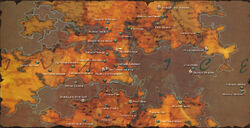
Map of Ivalice locations in Final Fantasy XII.
Ivalice (イヴァリース, Ivarīsu?) is a recurring world in the Final Fantasy series. Created by Director Yasumi Matsuno, Ivalice has been the setting of several games, one not even of the series. Matsuno wanted to expand Ivalice across a number of different titles so that it would stay within the memories of players.[1] Unlike many other Final Fantasy worlds, every game set in Ivalice happens in the same universe, usually at different periods in time. It first appeared in Final Fantasy Tactics, a spin-off entry to the series, and made its main series debut in Final Fantasy XII.
The Golden Age of Ivalice is derived from cultural influence of the Middle East, Turkey, India, and modern Metropolitan cities, while its post-Cataclysm era—represented by Final Fantasy Tactics and Vagrant Story—is inspired by Middle/Dark Ages- and Renaissance-era Europe. The Legend of the City of Ys especially comes to mind with the fall of the Holy Ydoran Empire.
Appearances
Final Fantasy XII
Ivalice is a region consisting of three continents: Ordallia in the west with a secret islet called the Den's Hideout, Valendia in the northeast, and Kerwon in the south. Only the lands bordering the Naldoan Sea are explored, although other Ivalician lands (the former Republic of Landis, for example.) are sometimes mentioned. In ancient times, King Raithwall united the three continents to establish the Galtean Alliance, but over time conflicts split the continents again.
The continents are dominated by an assortment of industrialized city-states: the Archadian Empire and the Kingdom of Nabradia in Valendia, the Rozarrian Empire in Ordallia, and sandwiched between the two the Kingdom of Dalmasca. Strategically located between the rival neighboring states Dalmasca's position as a neutral buffer region is eliminated when it is invaded by the Archadian Empire. Reduced to an occupied territory under Archadian rule, Dalmasca plays a central role in the still-heated dispute between its neighbors, which is again escalating.
Final Fantasy XII: Revenant Wings
A new sky continent is discovered and sky pirates rush to explore it while new threats to the mainland of Ivalice emerge. Most of the game takes place on the sky continent of Lemurés with locations from Final Fantasy XII briefly visited.
Final Fantasy XIV
The Final Fantasy XIV: Stormblood expansion introduces an alliance raid series called "Return to Ivalice," with Ivalice creator Yasumi Matsuno featuring as a guest creator.
Unlike the Ivalice Alliance titles, this Ivalice is not a world, but an ancient near-eastern region set in the world of Hydaelyn. This version of Ivalice has some events in common with the original world, such as a conflict also known as the War of the Lions.
Final Fantasy Tactics
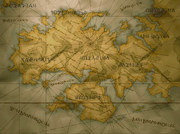
Map of Ivalice.
Ivalice is referred to as a kingdom, similar to a European country in the Middle Ages. It is a feudal society with a single major religion, the Church of Glabados, of which all Ivalicians are members, mirroring pre-reformation Christian Europe. Ivalice has recently suffered a series of wars that involved the invasion of neighboring kingdoms of Ordallia and Romanda. In the Fifty Years' War Ivalice opposed the armies of Ordallia, leading to the current destabilized political situation, and eventually the War of the Lions to decide the kingdom's true ruler.
Final Fantasy Tactics Advance
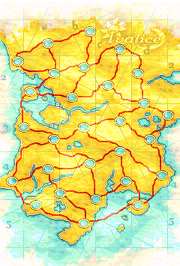
Map of Ivalice.
Ivalice is a kingdom created by Mewt Randell's imagination after he bought the Gran Grimoire from a bookstore. Mewt and his friends—as well as the entire town—were brought to this kingdom after Mewt uttered magic words to the Grimoire. Ivalice is influenced by classic Middle Eastern cultures as everything from the architecture, character design, and clothing patterns indicates an arabesque style.
The Ivalice of Final Fantasy XII is arguably based on the Ivalice in Final Fantasy Tactics Advance, although a more mature version; in Tactics Advance Ivalice was created by a child. Laws play an important role in this world, being supervised by the Judges of the palace. Hideo Minaba has stated his team tried to bring Arabic culture in the setting.[2]
Ivalice may also refer to St. Ivalice, Mewt's hometown.
Final Fantasy Tactics A2: Grimoire of the Rift
Ivalice is a geographical region rather than a kingdom. The land is not a dream world like in Final Fantasy Tactics Advance, but a region called Jylland, an area situated within the larger world of Ivalice, combining elements from Tactics Advance with Final Fantasy XII. Jylland is comprised of the Loar continent in the west and the western half of the Ordallia continent in the east. Luso Clemens is teleported to Jylland by writing his name in the Gran Grimoire.
Vagrant Story
Vagrant Story takes place within the kingdom of Valendia, which shares the name of a continent from Final Fantasy XII. The story spans three locations: the capital city Valnain, the Graylands, and the evil city of Leá Monde. There are several references to Ivalice, and Final Fantasy XII uses the Old Valendian Calendar. The Kiltia religion also features in both.
While Vagrant Story is not a Final Fantasy title, the game was designed by Yasumi Matsuno, the director and story creator for Final Fantasy Tactics and the original director for Final Fantasy XII.
Vagrant Story being set in Ivalice is actually a retcon, as originally nothing confirmed the game was set in that world. The game was not promoted as being connected to Final Fantasy Tactics on its release, and the Vagrant Story Ultimania makes no mention of Ivalice. At the time, Yasumi Matsuno stressed he made Vagrant Story to move away (at least temporarily) from the Final Fantasy Tactics universe. He stated the games are connected in 2004 in Final Fantasy XII interviews for a French gaming magazine, Joypad.[3] Before that, the allusions to Final Fantasy Tactics in Vagrant Story could simply be seen as Easter eggs.
Story
Timeline

Timeline of Ivalice.
The chronological order of the games is the following:
- Final Fantasy XII
- Final Fantasy XII: Revenant Wings
- Final Fantasy Tactics A2: Grimoire of the Rift (main game)
- Final Fantasy Tactics
- Vagrant Story (not an official Final Fantasy title)
- Final Fantasy Tactics Advance
- Final Fantasy Tactics A2: Grimoire of the Rift (prologue & epilogue)
In Final Fantasy Tactics A2: Grimoire of the Rift, Luso is transported to an Ivalice in the timeline after Final Fantasy XII: Revenant Wings (when Vaan and Penelo fully become sky pirates, and hinted by the discussion they have with Hurdy) and before Final Fantasy Tactics (or during if his War of the Lions appearance is considered canon, which is possible, since Mewt gave the Grimoire he used in Final Fantasy Tactics Advance to Luso at the end of Final Fantasy Tactics A2: Grimoire of the Rift). This would also explain why Luso was looking for his friends in Final Fantasy Tactics: War of the Lions. If his War of the Lions appearance is canon, it would take place after the events of Final Fantasy Tactics A2: Grimoire of the Rift.
Final Fantasy Tactics A2: Grimoire of the Rift appears twice due to the appearances of Luso in both Ivalice and St. Ivalice.
The age of myths
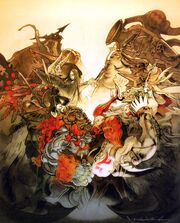
Scions of Dark.
The gods, calling themselves the Occuria in Final Fantasy XII, worked upon the world of Ivalice. They created the twenty-four scions based on zodiacs split as scions of Light and Dark, tasked with important objectives. Based on ancient texts, some believe there is a thirteenth scion. The scions of Dark rose against the gods and were bound to the world, hence only half appear as Espers in Final Fantasy XII.
- The creation myths of Ivalice are many, but one of the better known ones is as follows:Lua error in Module:Cite at line 82: Could not find an entry in Module:Codename/data or Module:Sources matching this input.
Before Ivalice was created, there existed two warring tribes of gods: the Fabar and the Danan. The war lasted for millennia until the Prophet Matoya predicted the death of the Danan god-king Xabaam in the hands of his trusted blade. Xabaam feared his trusted General Ahnas to be the death of him, and imprisoned him and his loyal followers into the darkest labyrinths. Ahnas implored the death-god Heth to free him in exchange for his own life. Freed along with his followers, Ahnas sought revenge.
Now Ahnas the Holy, he and his followers appeared millennia later upon the Fabar and battled the Danan triumphantly. The Fabar god We'aka was intrigued with the strength of his vengeance and swore an oath to fight alongside his men. Battles raged on for countless millennia until Ahnas finally confronted Xabaam and defeated him.
While We'aka sought the head of Xabaam, Ahnas wished the Danan god-king pay for his misdeeds and immortalized Xabaam's body, transforming it into a great land and named it Ivalice. Now Ahnas the Shining, he and his followers withdrew into the heavens, watching as Man lived and thrived upon Xabaam's eternal body.
The age of gods
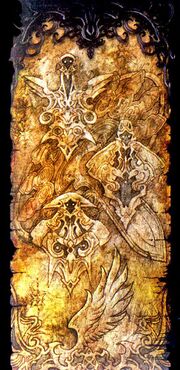
The Occuria.
Thousands of years before the Galtean Alliance was established, the Occuria ruled over Ivalice. While Man was starting to thrive the Occuria built imposing structures, such as the Pharos at the Ridorana Cataract. For reasons unknown the Occuria withdrew into hiding in the city of Giruvegan, causing mass confusion until the dawn of a new age.
Some believed the Occuria left because of the Thousand Years War incited by the twelve Espers, led by the corrupt Holy Seraph Ultima. The Espers were defeated and the Occuria, wanting to ensure the Espers would not rebel again, bound them into glyphs and banished them to the dark reaches within Ivalice.
The aegyl Feolthanos defied the Occuria and sealed himself and his people on the Purvama of Lemurés to evade their wrath. In secret, Feolthanos married a viera, whose offspring became a subspecies known as the feol viera.
Time of the glaciers
Ivalice was covered in ice, much like the ice ages of Earth. Many creatures adapted to a land-based way of life, but some creatures, such as the Croakadile, struggled surviving through the colder temperatures and their population dwindled. Eventually the glaciers began to melt as the temperature rose, flooding the lands. The sudden change in sea level killed many land species, and a number of surviving creatures, such as the Coeurl, were forced to adapt.
Magick enters Ivalice
Vague records claim that magick was brought to Ivalice from an unknown continent and into the hands of Man. It is unknown if the Occuria had a hand in this or not, as they are known to have given magick stones with great power to individuals of their choosing.
The Light of Kiltia
Circa 1294 years before the Valendian calendar, the Light of Kiltia was founded in Ordalia by a prophet of the same name with Mt Bur-Omisace at its center. The dualistic faith worshiped a polytheistic pantheon, led by Faram, the father. It was an early precursor to the Church of Glabados, and also influential to the Iocus Priesthood.
The Galtean Alliance

King Raithwall with a piece of deifacted nethicite.
Circa Old Valendian 1, Ivalice was at war. The Occuria, fearing Ivalice would be scarred further, gave the garif a large piece of nethicite, a weapon to set everything straight. The garif were unable to use it and, angered at the garif's incompetence, the Occuria came to learn of Raithwall's victory over the Esper Belias. Amazed, they gifted the nethicite along with the Sword of Kings to him.
Taking three shards off the motherlode of nethicite, the Sun-Cryst, King Raithwall united Ivalice and became known as the Dynast King and the founder of the Galtean Alliance. The Empires of Archadia and Rozarria arose and expanded quickly.
King Raithwall was buried with the Dawn Shard, and his tomb is guarded by an Esper he had defeated in life, Belias. The Dusk Shard went to the Kingdom of Dalmasca, while the Midlight Shard went to the Kingdom of Nabradia.
In Final Fantasy Tactics A2: Grimoire of the Rift, the Ruins of Delgantua are described as dating back to the Galtean era. This is further evidenced by the ancient stone architecture that composes its rooms and halls.
The Dancer-Priestess Müllenkamp lived during this era. A practitioner of the darker arts of Kiltia, Müllenkamp amassed a following, created many magickal Grimoires, and founded the city of Leá Monde. The Blood-Sin tattoo on her back was passed down through her family after her death, and serves as the key to Leá Monde.
If the Zodiac Braves from the Church of Glabados legend did exist, they lived in a warring period before the union of Ivalice, possibly a reference to the Galtean Alliance of this era.
The age of technology

Circa Old Valendian 706, the Empires of Rozarria and Archadia were at war. A truce was signed, but the son of Emperor Gramis Solidor, Vayne, assassinated his father and took over the Empire. He hoped to start a war with Rozarria and become Ivalice's new Dynast King, as he was being led by the rogue Occuria, Venat, who wished to shatter the control its kind had over Ivalice.
Vayne was stopped and killed by Princess Ashe of the Kingdom of Dalmasca, along with the sky pirates Balthier and Fran, street urchin Vaan and his friend Penelo, and a Dalmascan Knight-Captain Basch fon Ronsenburg. Ashe had been the Occuria's chosen, but opted to destroy the Sun-Cryst instead instead of carving new nethicite from it.
A year later, the Purvama of Lemurés was revealed to Ivalice along with the mysterious aegyl race. This sparked a treasure hunting spree among sky pirates that a maddened Feolthanos attempted to exploit. The party who stopped Vayne Solidor, along with some new friends, also defeated Feolthanos and restored peace to Ivalice.
The cataclysm and the age of Ajora
Circa Old Valendian 800 a great catastrophe hit Ivalice, wiping out many landmarks and taking out many races, including the moogles. Man started referring to the previous era as the Golden Era and rebuilt the world from the ground up.
In an age where airships and robots were commonplace, Pharism became the dominant religion of the Holy Ydoran Empire. A man called Ajora at the age of twenty started to preach about the coming of Paradise. His influence incited unrest among the Pharist priests, and Ajora was caught and hanged by the Empire after which an earthquake wiped out Ydora and sunk Mullonde into the sea.
Some took this as a divine sign and started praising Ajora as a child of the gods. Over the next few decades Ajora's tale would become twisted to valorize him. The Church of Glabados was founded by Ajora's disciples with Saint Ajora as its cynosure. Pharism faded with the Church of Glabados becoming the main religion. Presumably, Germonique wrote his scriptures around this time, describing Ajora in a less favorable light.
The War of the Lions
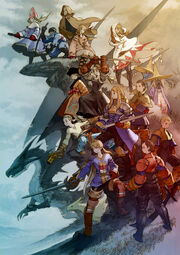
War of the Lions.
Circa Old Valendian 2000, Ivalice was again at war between two men seeking the throne. In reality, the war was a means for a greater evil. The Espers, now calling themselves Lucavi, wanted to return to rule Ivalice and possessed people to use them to do their bidding. It turned out Ajora had been being possessed by the Lucavi's leader, Ultima, who was then trapped in Ajora's body when he died. Using the War of the Lions, the new leader of the Lucavi, Hashmal, hoped to revive her.
The Lucavi amassed an abundance of bloodshed to revive Ajora, Ultima's last host, but a young man called Ramza stopped them. Ramza became labeled a heretic, and his old friend, Delita Heiral, went down in history as the man who ended the war. The only one who knew the truth, Orran Durai, was executed by the Church of Glabados as a heretic. Several decades on, Orran's descendant, Arazlam Durai, discovered his writings and decided to bring the truth to light.
While not historically relevant, Luso Clemens appeared during this time period, but how he got there is unknown. He may have used the powers of his Grimoire of the Rift to return to Ivalice in a different era once he was freed from his imprisonment.
Balthier from Final Fantasy XII also appeared in this era, claiming to have been brought to Ivalice's future by the Cache of Glabados. It can be speculated that during his time as sky pirate Balthier found a magickal artifact that transported him through time. This is further supported by his statement at the end of Final Fantasy XII of going after the Cache of Glabados.
The Graylands incident
Previously, a Kildean priestess named Müllenkamp founded the city of Leá Monde. Her followers created a cult after her and as time passed, a man called Saint Iocus began prohibiting the use of magicks. The influence of the Iocus priesthood increased, and followers of Müllenkamp were hunted down in the Inquisition. The prosperous city of Leá Monde was struck by a great earthquake, turning it into a concentration of dark energy and lost souls. Circa Old Valendian 2000, Riskbreaker Ashley Riot of Valendia entered Leá Monde to stop Sydney Losstarot, a Müllenkamp cultist leader with an unknown objective.
Ashley discovered the real threat was Romeo Guildenstern who wanted the power of the Gran Grimoire. Stripping Sydney of his power, he revealed the entire city was the Grimoire. Ashley stopped Romeo, and in turn was granted the dark powers of Leá Monde. Ashley became the vagrant, eternally saving lost souls who had become the undead.
The true Zodiac Brave Story
Circa Old Valendian 2400, Arazlam Durai, a descendant of Orran, revealed the truth about Saint Ajora, the Scriptures of Germonique, and the War of the Lions.
The modern age(?)
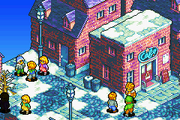
St. Ivalice.
It is unknown if St. Ivalice in Final Fantasy Tactics Advance is a location in the same Ivalice as seen in the other games. It is possible its name merely alludes to it.
If St. Ivalice is taken to belong to the same world, it depicts a world several centuries in the future where magick has vanished and been replaced by technology. In a small town a young boy called Mewt Randell buys an ancient book, the Gran Grimoire. Leafing through it with his friends, Marche and Ritz, along with Marche's little brother Doned, the book creates an Ivalice following Mewt's designs, who in turn is inspired by a Final Fantasy game and the grimoire's illustrations. Marche eventually reverts the world to normal knowing it isn't healthy to live in a dream world.
Ten to twenty years later a young boy called Luso finds the Gran Grimoire, but unlike Mewt's experience, this time the Gran Grimoire sends Luso back in time to the Golden Era. It is possible this is not the same grimoire Marche used, as in Final Fantasy Tactics A2: Grimoire of the Rift the book is referred to as the Grimoire of the Rift.
Alternatively it is possible that the presence of Final Fantasy Tactics Advance in Ivalice itself is a retcon, as material related to Tactics Advance noted the existence of a civilization that was destroyed by Noah's flood.
Recurring characters
Many of the characters in Ivalice have recurring roles due to the games in Ivalice being based in the same world.
Some examples are:
- Montblanc in Final Fantasy XII, Final Fantasy Tactics Advance, and Final Fantasy Tactics A2: Grimoire of the Rift.
- Nono in Final Fantasy Tactics Advance, Final Fantasy XII: Revenant Wings, Final Fantasy XII, and is mentioned at Final Fantasy Tactics A2: Grimoire of the Rift.
- Sorbet in Final Fantasy XII and Dive II Hunt: The Adventures of Sorbet.
- Hurdy in Final Fantasy XII and Final Fantasy Tactics A2: Grimoire of the Rift.
- Balthier in Final Fantasy XII, Final Fantasy XII: Revenant Wings, and Final Fantasy Tactics: War of the Lions.
- Ezel Berbier in Final Fantasy Tactics Advance and Final Fantasy Tactics A2: Grimoire of the Rift.
- Luso Clemens in Final Fantasy Tactics: War of the Lions and Final Fantasy Tactics A2: Grimoire of the Rift.
- Penelo in Final Fantasy XII, Final Fantasy XII: Revenant Wings and Final Fantasy Tactics A2: Grimoire of the Rift.
- Vaan in Final Fantasy XII, Final Fantasy XII: Revenant Wings and Final Fantasy Tactics A2: Grimoire of the Rift.
- Al-Cid Margrace in Final Fantasy XII, Final Fantasy XII: Revenant Wings, and Final Fantasy Tactics A2: Grimoire of the Rift.
- Mewt Randell in Final Fantasy Tactics Advance and Final Fantasy Tactics A2: Grimoire of the Rift.
- Ashelia B'nargin Dalmasca or "Ashe" in Final Fantasy XII, Final Fantasy XII: Revenant Wings and was to appear in Fortress.
The Montblanc, Nono, and Ezel that appear in Final Fantasy Tactics Advance are part of the dream world Mewt created with the help of the Gran Grimoire, but Montblanc possibly retains memories of the dream Ivalice.
Gallery
Trivia
- The stories set in Ivalice tend to be narratives. The events of Final Fantasy Tactics are being told to the player by Arazlam Durai, using the Durai Papers as his source. Vagrant Story appears to be a investigative report on the Graylands Incident. Similarly, Halim Ondore IV narrates some of the story of Final Fantasy XII from his memoirs, and Penelo and the rest of the party are implied to have written the story of Final Fantasy XII: Revenant Wings into the Logbook.
- Some timelines suggest that the events of Vagrant Story happened concurrently with Arazlam Durai writing the Durai Papers, circa Old Valendian 2400. This is based on information which appeared on the official Vagrant Story website.

